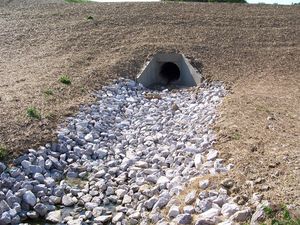
Difference between revisions of "Sediment control practices - Outlet energy dissipation"
| Line 8: | Line 8: | ||
[[File:Example of riprap outlet protection.jpg |right|thumb|300 px|alt=This picture shows an example of riprap outlet protection symbol for Stormwater Disconnection in MIDS calculator|<font size=3>Example of riprap outlet protection</font size>]] | [[File:Example of riprap outlet protection.jpg |right|thumb|300 px|alt=This picture shows an example of riprap outlet protection symbol for Stormwater Disconnection in MIDS calculator|<font size=3>Example of riprap outlet protection</font size>]] | ||
| + | |||
| + | ===Purpose and Function=== | ||
| + | |||
| + | Energy dissipators intercept incoming flows from pipes and ditches and deflect, scatter, or otherwise neutralize the erosive force of concentrated, moving stormwater. These structures are intended to protect soil from turbulence and high velocities, which can otherwise cause scour erosion. They typically consist of a structural apron lining fabricated from riprap, concrete, turf reinforcement mats, or other structural materials. Certain types of basins (e.g., settling/stilling/impact basins) can also function as energy dissipators. Many of these techniques are effective and relatively inexpensive and easy to install. Energy dissipators require careful design based on the hydraulic forces of concentrated flows exiting pipes and ditches. | ||
| + | |||
| + | ===Applicability=== | ||
| + | |||
| + | Energy dissipators at pipe and ditch outlets are appropriate for any unpaved or otherwise non-armored location where concentrated flows are discharged to areas subject to erosion. | ||
| + | |||
| + | ===Site Applicability=== | ||
| + | |||
| + | Energy dissipators are used where concentrated flows are discharged against channel banks, on poorly stabilized slopes, or onto upslope areas that are not protected against erosive flows. They are appropriate | ||
Revision as of 16:37, 18 October 2016
This page is under development. We anticipate populating it in autumn, 2016.
Contents
Outlet Energy Dissipation (Scour Protection)
Definition
Permanent or temporary energy dissipators prevent erosion, turbulence, and turbidity where stormwater pipes or ditches discharge to unprotected areas, such as channel banks, slopes, or upslope outfall locations. Their main purpose is to reduce the speed of concentrated flows to prevent scour at conveyance outlets. This practice is also called Scour Protection or Outlet Protection. Common types of outlet protection devices include concrete aprons, riprap-lined basins, and settling (stilling) basins.
Purpose and Function
Energy dissipators intercept incoming flows from pipes and ditches and deflect, scatter, or otherwise neutralize the erosive force of concentrated, moving stormwater. These structures are intended to protect soil from turbulence and high velocities, which can otherwise cause scour erosion. They typically consist of a structural apron lining fabricated from riprap, concrete, turf reinforcement mats, or other structural materials. Certain types of basins (e.g., settling/stilling/impact basins) can also function as energy dissipators. Many of these techniques are effective and relatively inexpensive and easy to install. Energy dissipators require careful design based on the hydraulic forces of concentrated flows exiting pipes and ditches.
Applicability
Energy dissipators at pipe and ditch outlets are appropriate for any unpaved or otherwise non-armored location where concentrated flows are discharged to areas subject to erosion.
Site Applicability
Energy dissipators are used where concentrated flows are discharged against channel banks, on poorly stabilized slopes, or onto upslope areas that are not protected against erosive flows. They are appropriate
